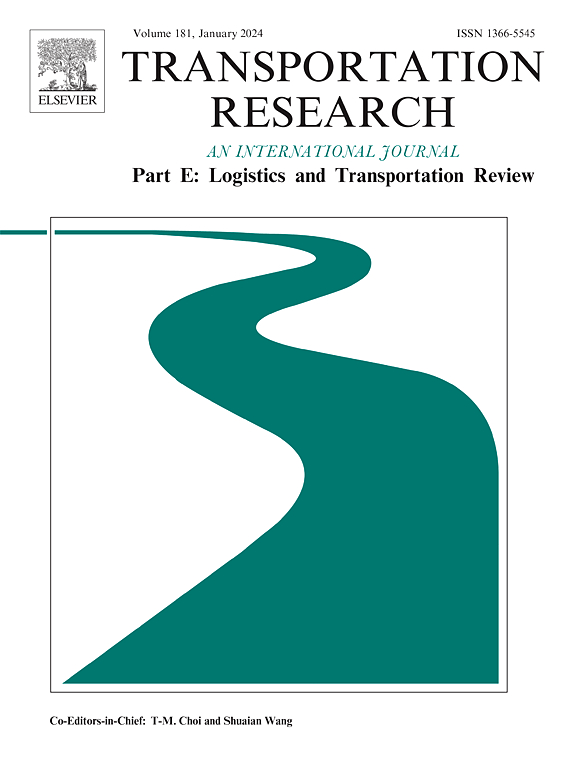Simultaneous estimation of induced, diverted, and ex-post demand for railway passengers: an interpretable machine learning framework based on constrained computational graphs
IF 8.3
1区 工程技术
Q1 ECONOMICS
Transportation Research Part E-Logistics and Transportation Review
Pub Date : 2025-07-21
DOI:10.1016/j.tre.2025.104283
引用次数: 0
Abstract
Passenger flow on train lines is driven by how travelers respond to service offerings and constraints within the railway system, shaped primarily by three factors: Diverted demand refers to a shift in travelers’ choices toward different train lines, quantified by analyzing changes in the probability of selecting a particular train line within a given line plan. Induced demand arises when improvements in service quality led to an increase in passenger demand within a railway system. Ex-post demand occurs when seat capacity constraints force travelers to make choices that deviate from their initial preferences. This paper aims to develop a systematic and theoretically consistent methodology to estimate the three types of demand that drive overall demand variation. To integrate these estimation modules, a computational graph-based learning architecture is proposed to solve the railway passenger demand estimation (RPDE) problem. The RPDE problem simultaneously estimates passenger boarding and alighting at stations, OD trips between stations, and passenger flows loaded onto train lines. The behavioral parameters associated with travel time, ticket price, and line frequency are also calibrated. A novel four-stage adapted alternating direction method of multipliers (ADMM), enhanced by backpropagation, is proposed to solve the RPDE problem to ensure consistency between modules and enable efficient solutions. We demonstrate the effectiveness of the method through scenario analyses, quantifying the composition of the demand, and revealing their implications for policymaking. A real-world case study in the Beijing-Shanghai high-speed rail corridor is used to demonstrate the applicability of the proposed approach.
铁路乘客诱导、分流和事后需求的同时估计:基于约束计算图的可解释机器学习框架
铁路线路上的客流是由旅客对铁路系统内的服务提供和限制的反应驱动的,主要由三个因素决定:转移需求是指旅客对不同列车线路的选择的转变,通过分析在给定线路计划中选择特定列车线路的概率变化来量化。当服务质素的改善导致铁路系统内乘客需求增加时,便会产生诱导需求。当座位容量限制迫使旅行者做出偏离最初偏好的选择时,就会出现事后需求。本文旨在开发一个系统的和理论上一致的方法来估计驱动总需求变化的三种类型的需求。为了整合这些估计模块,提出了一种基于计算图的学习体系结构来解决铁路旅客需求估计问题。RPDE问题同时估计在车站上下车的乘客,车站之间的OD行程,以及列车线路上的客流。与旅行时间、票价和线路频率相关的行为参数也被校准。提出了一种基于反向传播增强的四阶段自适应交替方向乘法器(ADMM)方法来解决RPDE问题,以保证模块间的一致性并实现高效解。我们通过情景分析,量化需求的组成,并揭示其对政策制定的影响,证明了该方法的有效性。以京沪高铁走廊为例,验证了该方法的适用性。
本文章由计算机程序翻译,如有差异,请以英文原文为准。
求助全文
约1分钟内获得全文
求助全文
来源期刊
CiteScore
16.20
自引率
16.00%
发文量
285
审稿时长
62 days
期刊介绍:
Transportation Research Part E: Logistics and Transportation Review is a reputable journal that publishes high-quality articles covering a wide range of topics in the field of logistics and transportation research. The journal welcomes submissions on various subjects, including transport economics, transport infrastructure and investment appraisal, evaluation of public policies related to transportation, empirical and analytical studies of logistics management practices and performance, logistics and operations models, and logistics and supply chain management.
Part E aims to provide informative and well-researched articles that contribute to the understanding and advancement of the field. The content of the journal is complementary to other prestigious journals in transportation research, such as Transportation Research Part A: Policy and Practice, Part B: Methodological, Part C: Emerging Technologies, Part D: Transport and Environment, and Part F: Traffic Psychology and Behaviour. Together, these journals form a comprehensive and cohesive reference for current research in transportation science.

 求助内容:
求助内容: 应助结果提醒方式:
应助结果提醒方式:


